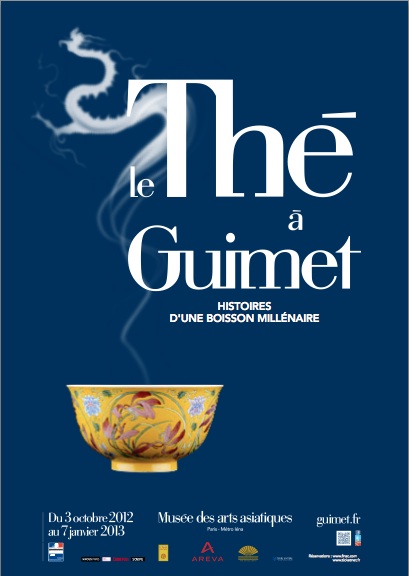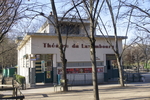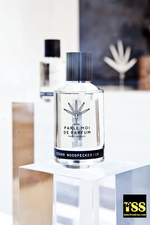Visit to Musée Guimet to See & Smell Le Thé, Histoires d'une Boisson Millénaire - Histories of an Age-Old Beverage {Scented Paths & Fragrant Addresses}

A new exhibition opened on October 3, 2012 at Musée Guimet, the Parisian museum consecrated to the Asian Arts, called Le Thé, histoires d'une boisson millénaire (Tea, histories of a an age-old beverage). As curator Jean-Paul Desroches underlines, it is a sequel to the exhibition of Quai Branly, Les séductions du palais, which was devoted last summer to a retrospective of Chinese cuisine. The new exhibit runs until January 17, 2013.
It is well-worth visiting it if you are in Paris thanks to its clear presentation of the historiography of a material food source which is also a cultural object as well as to contemplate the aesthetic forms tea-drinking inspired.
People interested in perfumes are usually attuned to flavors and tea is certainly a companion product to perfume. Many artisan perfumers in North-America especially like to offer tea blends together with their fine fragrances. Tea shops more often than not sell scented candles so as to emphasize the idea that tea is a form of atmospheric perfume. And last but not least, tea has become a source of inspiration for perfumers since Jean-Claude Ellena made the creative leap ca. 1993 - in the era of Calone and watery scents - to compose a perfume to be worn on skin as if it had captured for a much longer period of time the fragrant steam that comes out of the spout of a teapot. His Eau Parfumée au Thé Vert by Bulgari is considered as a landmark fragrance...
Since then, there have been tea accords and tea perfumes too numerous to list easily. Jo Malone not long ago devoted a collection to the idea even including milky tea. This is the only part which is missing from this exhibition, a historical chapter on the prolific perfumery which was inspired by this ancient beverage due to the specialization of the museum. But what is noteworthy for olfactophiles is the fact that commercial partner Le Palais des Thés has assembled a secondary exhibition which is based on the senses of seeing, smelling, tasting and touching. There is even a diplay destined to toddlers where they can smell tea blends almost at ground level (my 9-year old son had to kneel down). The exhibition includes also a short film showing tea master Tseng Yu Hu inhaling teas and analyzing them live on camera.
Tea is therefore indeed presented not just through erudition, history and appreciation of forms, but also through the evocation of the art of smelling.
Upon entering the first room of the exhibit, you experience a visual shock for a thing of beauty when seeing the 1-ton brick of compressed tea that famous Chinese conceptual artist Ai Weiwei created for the retrospective. Imitating the traditional form of the brick of tea but making it look monumental and modern with its "cubist" aesthetic, the creator explained that he wanted to show the mix of tradition and modernity that tea straddles. The lighting makes this piece of art feel more dramatic, adding a sense of mystery to it, as if it were an alien, opaque object in 2001: A Space Odyssey, but at the same time, the clearly recognizable texture of tea leaves and twigs make it feel earthy and even archaic. I wonder, since Ai Weiwei lived for many years in the Western province of Xin-Jiang where his father poet Ai Qing was deported, if he might not have been unconsciously influenced by the symbol of the Kaaba, the region being Muslim. His work looks like a reduced Kaaba made of tea.
Most of the artifacts on show are antiquities as the historiography reveals how evolving tea techniques and tea perceptions were reflected in the containers that were used to prepare the most popular brew in the world. The three main periods correspond to three main techniques. They are the Age of Boiled Tea during the Tang Dynasty (618-907); the Age of Whipped Tea during the Song Dynasty (960-1279); the Age of Infused Tea from the Ming Dynasty to the Qing's (1368-1911).
Today we continue to have access to all three forms of tea preparations. If you have tasted Tibetan or Mongolian tea, then you are partaking of the earliest style of tea-making. Whipped Tea can be experienced in the Japanese tea ceremony; most people today however infuse their teas and this is how it is usually interpreted in perfumery.
The foundational act that opened the way for that latter practice which is so widespread in the contemporary world is a decree promulgated by Emperor Hongwu in 1391 which imposed a return to simplicity. Chinese literatti were seduced by this new-found purity and made it coincide with a reflection on the vanities of the world, bringing the beverage to mountainous retreats, filling their teapots with the water from pristine sources, lighting a small, portable tea stove called kujiejun.
The art exhibition displays ceramics, tea utensils, paintings and manuscripts with an emphasis on the first. It is fascinating to see how ceramic forms were studied so as to provide optimal results in whipping tea for instance. Tea cups were then not just for drinking but were kitchen utensils at the same time. Philosophical oulooks influenced the shapes of tea cups which could reflect the quest for non-perfection just like the quest for ostentatiousness depending on the period and geographic area. The delicate nuances of prized glazes have to be appreciated in situ. If you love color, you will be able to see rare tints. One will discover also how Western art influenced so-called "chinoiseries" motifs such as the tea cups influenced by the works of enameled brass of Versailles (see exhibit poster).
The spread of tea culture was closely linked to religious and philosophical history. It was encouraged by the spread of Buddhism. It is during the 6th century A.D. that tea takes over wine. A treatise by Chajiu Lun entitled "Discussion between tea and wine" shows the importance the topic represented for literatti. A painting at the expo shows Daoist sages looking drunk while Buddhist wise men sit erect yet relaxed at the same time, with none of the bawdiness betrayed by Daoists. The political implications of a prosperous and monopolist trade are also stressed. Tea arrives in Europe in 1606 but it is not before 1848 that the English manage to solve the mystery of its manufacturing giving henceforth birth to Darjeeling.
Perfume lovers will particularly enjoy the short film featuring tea master Tseng Yu Hu who hails from Taiwan. She has worked with chefs and perfumers in the past. Her nose discerns dozens of olfactory nuances in a tea cup. These can range from the scent of the forest soil to the scent of her grand-mother's home. Her gaze shows the intensity of her concentration to find those fragments of the olfactory world in the exhaling tea. Her gestures are quasi ritualistic as she gradually extracts the perfume from the tea leaves with steamy hot water. She does not drink tea, she prefers to smell it deeply.
A separate, small room attempts to offer a glimpse of other traditions besides the Asian ones but it is so sketchy as to making you wonder if it were really worth it. A Russian samovar, Arabian tea kettles are shown but feel somehow superficial paid lip-service to next to the efforts put into the main thread weaving Eastern and to a lesser extent, Western influences.
More than with "Les séductions du palais," the senses are engaged in this exhibition. If the special green tea blend devised by Le Palais des Thés "Le thé Guimet" is pleasant to drink but not what one would call arresting - it mostly tastes of cherry flowers - and the blends offered to the sense of smell but also to our visual appreciation are contemporary and commercial - le Thé des Moines smelled particularly good - rather than reconstituted or culturally and historically pertinent, we can nevertheless applaud a scenography which is making room, and no doubt will do so even more in the future to learning not only thanks to our intellect but to our senses, even the most neglected one.
More information can be found here, including on tea workshops organized by the museum.









